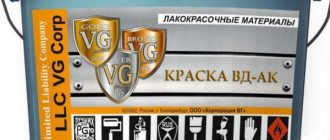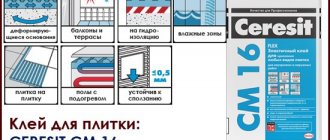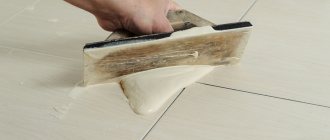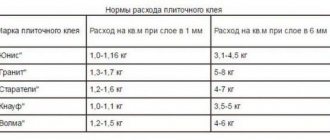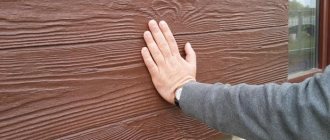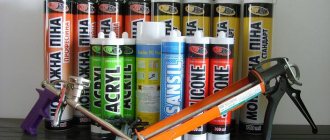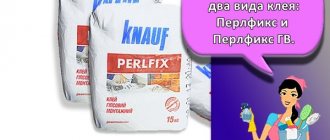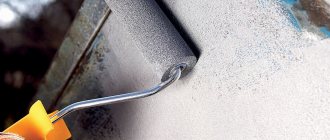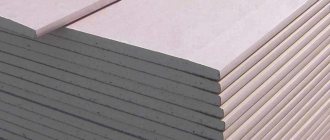After the work on laying ceramic tiles has been completed, you need to learn how to dilute Ceresit grout in order to protect the seams and the treated surface from moisture, dirt, and also to give an aesthetic and finished look to the finish. If you choose Henkel products for work, then there will be no problems, for example, how to dilute grout for Ceresit CE33 tiles, since the same general principles of working with similar dry mixtures apply to this cement-based material, which is popular among builders.
General rules for preparing mortar for grouting ceramic tiles
Of no small importance when working is the method and technology of its dilution, information about which is contained in the instructions for the material. But in some cases, some secrets that specialists with extensive experience know will also be useful.
The classic dilution method is not difficult for a beginner and is suitable for almost all types of grout, mainly cement-based.
To do this you should:
- pour the required amount of dry grout mixture into the prepared container;
- pour water into it in the proportion specified in the instructions;
- mix thoroughly until a homogeneous paste-like mass;
- you can mix either manually or using special devices - for example, a drill with a mixing attachment;
- leave the solution alone to “mature” for five minutes, and then mix it thoroughly again.
It is important to consider that you should not immediately use all the grout mixture prepared for processing joints, since its working time is no more than 1 hour and if the volume of work is large enough, part of the solution will simply disappear, as it will harden before it is used.
It is strictly forbidden to dilute the slightly set mixture with additional water, as this will not bring the expected effect, and the composition will simply be spoiled. It is better to slightly slow down the process of setting the solution by stirring it constantly while working.
Craftsmen who specialize in laying ceramic tiles are, of course, armed with the necessary tools, but for a home craftsman there is no need for extra expenses. Therefore, given that grout solutions are rarely produced in large volumes, it is quite rational to mix everything manually. But if you want to make your task easier, you can use a container with a fairly wide neck and a closing lid and simply mix the solution in it, shaking it vigorously.
How to dilute tile grout
How to dilute tile grout economically and correctly?
Antip asks a question:
Good afternoon to everyone who has encountered repairs! My husband and I started a bathroom renovation that threatens to never end and go from a regular renovation to an eternal one. It would seem that the finish line is already looming on the horizon, but our tiles still don’t want to be ready. It's not the tile itself, but the grout for it. How to dilute tile grout correctly and economically so that the tile looks beautiful and holds firmly?
Tile grout is a colored solution designed for grouting joints. A correctly selected mixture will visually improve the laid tiles, make the surface more durable, and allow it to breathe. It is also capable of hiding defects caused by laying tiles and reducing the depth of seams if necessary.
Of course, the main task of such grouting is the aesthetic appearance of the surface. Here it plays the role of a frame for a picture, without which the entire artist’s work will seem unfinished. Playing with the color scheme of the mixture will help you achieve the desired style and decor and highlight the beauty of the room. That is why it is so necessary to properly mix the grouting compound so that it does not spoil what needs to be finished. A few rules will help answer the question: how to dilute tile grout?
- Before work, it is necessary to prepare the tiles, clean the seams, and wipe off dust and dirt.
- You should never dilute too much of the mixture, as it dries quickly. Literally in two hours it will no longer be possible to use it, as it will thicken.
- You should not add water to a thickened mixture to thin it. This will no longer save it, but will only disrupt the beneficial properties of the grout.
- There is no exact proportion of the amount of mixture, although builders usually dilute 150 g of dry grout per square meter, but this is an approximate calculation. It is better to “under-dilute” the grout than to throw away the damaged material. After all, you can always breed more.
- Before mixing the mixture, you must carefully read the instructions on the package. It's unlikely that the developers got the proportions wrong. Strictly following the instructions will allow you to achieve a creamy consistency that will not flow or, on the contrary, fall off in pieces when applied.
- Additional tools in this matter will come in handy. This is a drill with a special stirring attachment. In a word, the principle of a kitchen blender. Using this equipment will help you quickly and easily knead the tile mixture, making it as elastic and sticky as possible.
- Important to remember! After grouting, 10-12 hours must pass before you can begin to clean the seams and coat them with primer. This is how long it takes for the mixture to dry completely.
- pour the required amount of dry grout mixture into the prepared container;
- pour water into it in the proportion specified in the instructions;
- mix thoroughly until a homogeneous paste-like mass;
- you can mix either manually or using special devices - for example, a drill with a mixing attachment;
- leave the solution alone to “mature” for five minutes, and then mix it thoroughly again.
Perhaps these tips will help answer the question of how to dilute tile grout efficiently.
How to dilute Ceresit grout correctly?
After the work on laying ceramic tiles has been completed, you need to learn how to dilute Ceresit grout in order to protect the seams and the treated surface from moisture, dirt, and also to give an aesthetic and finished look to the finish. If you choose Henkel products for work, then there will be no problems, for example, how to dilute grout for Ceresit CE33 tiles, since the same general principles of working with similar dry mixtures apply to this cement-based material, which is popular among builders.
General rules for preparing mortar for grouting ceramic tiles
Of no small importance when working is the method and technology of its dilution, information about which is contained in the instructions for the material. But in some cases, some secrets that specialists with extensive experience know will also be useful.
The classic dilution method is not difficult for a beginner and is suitable for almost all types of grout, mainly cement-based.
To do this you should:
It is important to consider that you should not immediately use all the grout mixture prepared for processing joints, since its working time is no more than 1 hour and if the volume of work is large enough, part of the solution will simply disappear, as it will harden before it is used.
It is strictly forbidden to dilute the slightly set mixture with additional water, as this will not bring the expected effect, and the composition will simply be spoiled. It is better to slightly slow down the process of setting the solution by stirring it constantly while working.
Craftsmen who specialize in laying ceramic tiles are, of course, armed with the necessary tools, but for a home craftsman there is no need for extra expenses. Therefore, given that grout solutions are rarely produced in large volumes, it is quite rational to mix everything manually. But if you want to make your task easier, you can use a container with a fairly wide neck and a closing lid and simply mix the solution in it, shaking it vigorously.
How to properly prepare epoxy-based grout?
The process for preparing grout based on epoxy resin is somewhat different. In this case, deviations from the instructions are not allowed at all. At the first stage, the paste is mixed with a catalyst, which are thoroughly mixed, then a special color is added in the form of a powder, if necessary, since initially this grout has no color and is transparent.
After this, all the components of the epoxy grout are thoroughly mixed again and you can begin to work, but be sure to take into account that the mixture hardens very quickly and it is recommended to remove its excess from the surface of the tile immediately.
Features of working with grout for Ceresit tiles
Tile grout Ceresit CE33 is recommended for joints with a width of no more than 5 mm; if wider ones need to be processed, experts recommend slightly reducing the amount of water, that is, making the solution more dense, which will ensure better adhesion to the surface.
This type of grout has a wide range of colors - more than 25 colors and shades, and is suitable for both external and internal work.
In addition, Ceresit CE33 grout:
maintains performance characteristics over a wide temperature range, including sudden changes;
moisture-resistant and prevents the formation and development of various fungal colonies even in a constantly humid environment - for example, in the bathroom;
it is flexible, which makes it easier to work with even for a beginner;
not subject to cracking;
Made from components that are safe for the human body.
In cases where it is necessary to process seams with a width of more than 10 mm, it is recommended to use Ceresit CE40 grout with a high water-repellent effect, which makes its use for external work, primarily for facade finishing, indispensable.
Do you want to buy Ceresit building materials at the best prices in Moscow? Hurry up to place your order!
Which grout to choose for the joints between laid ceramic tiles and how to work with it correctly.
Grout for joints between ceramic and porcelain stoneware tiles, as well as mosaic elements, performs two main functions: protective and decorative.
It complements the sealing of the finished surface, preventing moisture from penetrating behind the cladding, and eliminates deformations of the cladding layer that can occur in it due to sudden fluctuations in temperature and humidity.
In addition, grout makes this surface more attractive.
Many manufacturers offer such products on the domestic market.
- Litokol,
- UNI5,
- trademarks "Osnovit" ("Stroy-montazh MS")
- Weber Vetonit (“Saint-Gobain Construction Products Rus”)
- trademark Ceresit (Henkel, Germany),
- Kiilto (Finland),
- Atlas (Poland),
- Mapei (Italy),
- Sopro (Germany).
Types of grout
The most common today are cement grouts.
They contain cement, mineral fillers, pigments and modifying chemical additives responsible for plasticity, frost resistance, resistance to cracking, etc.
All masters admit that modern tools are very convenient to use.
They are easy to prepare and apply; It's just as easy to remove un-hardened residue from the tile surface and clean the tools. High-quality cement-based joint fillers, after application and hardening, are characterized by good adhesion, high strength, water and color resistance.
Moreover, the number of colors from different manufacturers varies in the range of 5-30. These materials are used both indoors and outdoors. Naturally, for exterior finishing it is worth choosing a mixture with increased strength, water and frost resistance, and its packaging must have the inscription: “Suitable for outdoor use.”
Among the popular cement grouts are Weber.Vetonit TG (“Saint-Gobain Construction Products Rus”), the price of a package (5 kg) is from 180 rubles; Color (UNIS), package price (2 kg)—from 53 rubles; “Osnovit Plitsave” (“Stroymontazh MS”), package price (2 kg) - 93 rubles; Kesto (Kiilto), package price (1 kg) - 16 rubles (prices are given at the beginning of 2012).
Epoxy grouts, as their name suggests, contain epoxy resin. After hardening, it makes the tile joints dense, absolutely moisture-resistant and resistant to various chemically aggressive substances. In domestic conditions, this type of grout is used in conditions of constant humidity, for example, when lining swimming pool bowls, on the working surfaces of kitchen countertops and “aprons”.
They use, for example, Litochrom Starlike (Litokol), the price of a package (2.5 kg) is 1,700 rubles; Kegarohu Design (Mapei), package price (2.5 kg) - from 1,730 rubles.
The color range of epoxy grouts from some manufacturers includes up to 100 different shades. Due to their incredibly high ductility (tension can reach 500%), silicone grouts are used to fill joints located at the corners of tiled surfaces: between walls, walls and floors, as well as walls and ceilings.
You should not neglect them when finishing the joints of walls made of different materials (plasterboard and brick/concrete), since during operation, with changes in temperature and humidity, they expand and shrink differently. With such movements, cement joints will certainly crack, but silicone joints will not care. The main thing is that the color of the silicone mixture matches the tone of the rest of the seams. However, rubbing all the seams with silicone compounds is very expensive.
For example, a small package (280 ml) of Ceresit CS 25 grout (Henkel) costs from 180 rubles. Number of colors - 22, including transparent. Most experts agree that working with epoxy and silicone materials is not easy and no one succeeds in smoothly rubbing the seam the first time. In addition, the compounds set very quickly, and removing them from the surface of the tiles after hardening is extremely difficult. Therefore, it is better to entrust this work to professionals.
Choosing the “correct” grout mixture for tiles:
When choosing any type of grout, please note that the manufacturer must indicate the recommended joint width on the packaging. Thus, cement-based mixtures are usually divided into two categories according to the size of the joints being processed: for narrow (up to 6 mm) and wider (6 mm). Mixtures of the first group consist of small fractions and fill the space between tiles well without sticking to the tool. The second includes larger fractions, which are needed to get a more filled seam without depressions and avoid re-application of the mixture.
You should start grouting the joints 1-2 days after laying the tiles (if the simplest masonry cement-sand mortar is used as glue, no earlier than 7 days). The exact time interval that should be observed is indicated on the packaging of the tile adhesive. It is necessary to adhere to this so that the cladding has time to firmly adhere to the base. Otherwise, when filling the seams, you can accidentally move the tiles, and it will be difficult to return them to their place, restoring the integrity of the overall picture.
Novice craftsmen often ask the question: is it possible, without changing the good tile cladding, to replace only the grout, which has crumbled in places, cracked, or become covered with mold or mildew? Experts' opinions on this matter are divided. Some argue that the old compound must be completely removed from the seams, and then rubbed over again. Moreover, everyone understands that this is incredibly difficult to do. Others note that some manufacturers test joint fillers for repairability and, if they are suitable for such work, be sure to indicate this on the packaging and in the technical description. Of course, before using such a composition, all seams are thoroughly cleaned of poorly adhering pieces, household grease, dirt, colonies of fungi, mold, washed, and only then a new layer is applied.
Many people are concerned about another problem: why do initially beautiful and smooth seams become cracked over time? Most often this happens due to non-compliance with technology.
How to properly dilute grout for joints?
The dry grout mixture is added to a strictly defined amount of water and thoroughly mixed by hand, using a mixer or drill with an attachment. Then a technological pause (5 minutes) is maintained for the mortar mixture to mature and mixed again. The resulting composition must be consumed over a period of time (about 1 hour). Gradually it begins to thicken, and it becomes uncomfortable to work with. What to do?
The first thought that comes to a layman’s mind is to add water and mix. However, doing this is strictly prohibited. It is an overdose of water that leads to a deterioration in the technical characteristics of the grout. Simply put, all grout diluted with water will certainly crack over time. In order for the solution to remain plastic longer, it should be stirred more often or prepared in small portions, strictly observing the ratio of the mixture and water.
Carry out work, including repairs, preferably in dry conditions, at an air and base temperature of 5-30 degrees and a relative air humidity of no more than 80%. All indicators stated in the technical description (mortar lifetime, setting time and strength gain) are correct for an ambient temperature of 20 ° C and a relative air humidity of 60%. In other conditions, they may change. For example, when working in a too dry atmosphere (air humidity less than 40%), to prevent the grout from drying out, which can lead to loss of strength, open containers with water, air humidifiers, or spray water are installed in the room. Seams filled with cement grout are periodically moistened with a wet sponge.
Surprisingly, it turns out that the main competitor of joint grout is tile adhesive. The logic of the reasoning of workers who do not want to complicate their lives by choosing a filler for joints is quite understandable: “We already have a gray adhesive mass, why buy another one?” However, the chemical composition of the adhesive mixture differs from the grout mixture - it is designed to ensure only good adhesion of the tile to the base.
Therefore the seams. filled with glue, they have a lumpy, uneven matte gray surface. They are easy to scratch. They do not have water-repellent properties, they get wet if water gets on them, and over time, gullies even appear on the surface.
Due to the lack of fungicidal additives, mold and mildew develop more actively on seams with an adhesive mixture. Grout mixtures contain many modifying additives that are not found in glue.
Their cost, naturally, is higher, but not enough to justify such savings, and the consumption of grout is quite small.
And most importantly, modern joint fillers successfully perform a decorative function, since there are many colors, shades and various effects to choose from: “metallic”, “diamond chips”, “gold dust”, “luminescent”, etc.
Grouting joints with a two-component epoxy mixture:
Jointing is simultaneously leveling and compacting the top layer of the mixture that fills the space between the tiles.
There is no special tool for this process, so craftsmen do it with a round pencil or just a finger or a spatula described here.
After laying the tiles, it is advisable to inspect all the seams and immediately remove excess tile adhesive from them. Indeed, when installing each element, the adhesive composition is partially squeezed out on the sides and fills the space between the tiles: in some places less, in others more. If you do not remove excess glue, after 24-48 hours (when you should start grouting) it will harden. As a result, the grout will lie well on partially empty seams and will look even and uniform in color. And in those places where the glue remains close to the surface of the seam or even comes through, textured and color spots are formed, especially noticeable against the background of colored grout compounds. Ideally, the seams should be filled with glue to approximately 13, but if work is done carelessly, glue bumps often rise above the surface of the cladding. Insufficient cleaning of seams is one of the common mistakes. It is worth following this so that as a result of applying the grout you do not give the impression of a sloppy job, but, on the contrary, create a coherent, effective picture of the finished beautiful cladding.
- catalyst(s) is poured into the container with the paste,
- mix with an electric drill with a nozzle (6),
- add gold powder (c)
- mix again (d).
- The seams are filled with a spatula with a rubber nozzle (e).
- Then carry out primary cleaning of the surface (e),
- moisten the lining with water from a spray bottle (g)
- and clean again (h).
- Then use a liquid cleaning agent, for example, Litonet (and),
- remove the remaining mixture with a grater with a cellulose attachment (k) and a sponge (l).
- Finally, wipe dry with a napkin (m). Complete curing of the composition occurs after 3-5 days (n)
Tips for someone learning how to grout joints between tiles with their own hands:
Below are other entries on the topic “How to do it yourself - for a homeowner!” Reviews and comments: 3
Marina and Nikolai Kruglov, Veliky Novgorod 2016-07-19 (18:23) #
We paint ceramic tiles with our own hands After moving into my parents’ apartment, I wanted to refresh the interior of the bathroom. But I didn’t want to carry out a complete renovation, removing completely intact tiles. It turned out that simply repainting the tiles was enough. You needed: a stiff brush, cleaning powder, water-dispersed latex paints, a brush, a roller, a primer, and sandpaper. Using a stiff brush and cleaning powder, thoroughly washed the tiled walls. Let it dry. Using fine sandpaper, we sanded the old tile until its surface became slightly rough. Construction dust was removed with a clean dry rag. We degreased the wall surface with white spirit, paying special attention to the seams. Dried and coated with primer. Several thin layers of paint were applied with a foam roller, allowing complete drying in between. Seams and hard-to-reach places were painted over with a brush. Such cosmetic repairs were quite inexpensive.
Guest of the site “With Your Hands” 2016-07-02 (12:25) #
Where are the breeding proportions??
Hello everyone, good article about ceramics, but I wanted to share my experience, I recently ordered luxury ceramics from one company, the tiles are just super, my wife is also very happy)
- How to remove old grout from tile joints? When should grout be removed? Preparatory work Mechanical methods for removing grout Chemical methods for removing grout Updating…
- Tile grouting tool Grouting tool Grouting tool To apply LITOCHROM STARLIKE epoxy grout, it is recommended to use a set…
- Grout consumption per square meter of tiles What is worth considering? Calculation method What materials and tools still need to be purchased? When we trust...
- How to calculate the number of tiles for the floor How to calculate the tiles for the floor using different installation methods Getting started with the repair and installation of flooring…
How to properly prepare epoxy-based grout?
The process for preparing grout based on epoxy resin is somewhat different. In this case, deviations from the instructions are not allowed at all. At the first stage, the paste is mixed with a catalyst, which are thoroughly mixed, then a special color is added in the form of a powder, if necessary, since initially this grout has no color and is transparent.
After this, all the components of the epoxy grout are thoroughly mixed again and you can begin to work, but be sure to take into account that the mixture hardens very quickly and it is recommended to remove its excess from the surface of the tile immediately.
Range of performance characteristics of Ceresit fugues: all types
Grouts are sold in the form of dry mixtures or ready-made solutions. To improve the quality of seams, coloring pigments and special water-repellent substances are added to them.
The task of grouting is to give the tile masonry a completed look, and in addition, not to allow moisture to penetrate deep into the joints, which can destroy the glue.
The use of grout prevents the formation of fungus, this is especially true for “wet” rooms: bathroom, kitchen, swimming pool and bathhouse. And, of course, grouting makes cleaning much easier: dirt and dust do not accumulate in the seams.
All this will work if the composition of the mixture is chosen correctly. And this is not as simple as it seems at first glance. There are many types of mixtures and each of them is designed for special conditions of application and operation.
It is necessary to take into account not only the composition, but also the color of the grout, its behavior in an aggressive environment
It should be noted that Ceresit brand products have a wide range of choices, so it makes sense to study the most popular formulations and choose the one that suits you.
Ceresit CE 33 Super – 26 shades for the bathroom
This type of mixture is suitable for processing thin joints up to 6 mm wide. It is also chosen because these Ceresit grouts have a rich range of colors, ranging from white to black.
This grout has an innovative formula that prevents the growth of bacteria on the surface and deep in the cladding seams
After hardening, Ceresit CE 33 grout of any color from the palette gives a smooth and even surface that is not afraid of either water or sub-zero temperatures. Resistance to frost allows this model to be used for outdoor work, for example, when finishing the facade with ceramic tiles or imitation stone masonry.
In repair work, it is recommended to combine Ceresit CE 33 tile grout with a silicone analogue for additional treatment of joints in plumbing fixtures.
Ceresit CE 33 Super
Related article:
Ceresit CE 35 Super – for decorative work with stone
This type of mixture shows excellent results in wide joints up to 15 mm. It is used in laying glass blocks and decorating masonry. Among other things, such grout can be used on cladding with a risk of deformation.
If you add an elasticizer to the composition, Ceresit CE 35 Super will perform well in an outdoor pool
Ceresit CE 35 Super
Ceresit CE 43 Super Strong – super strength on wide seams
This mixture can reliably seal a 40mm thick joint, and it's no joke. It also contains antifungal additives and elasticizers that prevent seams from cracking during use.
This composition can be used for work inside and outside, has 9 main colors and is packaged, among other things, in bulk bags of 25 kg
Ceresit CE 43 Super Strong
Ceresit CE 40 Aquastatic – not afraid of moisture
The name Aquastatic itself already speaks of the special characteristics of the mixture. The powerful water-repellent formula of Ceresit CE 40 Aquastatic tile grout, complete with antibacterial additives, makes this grout the best choice for swimming pools and saunas. An undoubted advantage of Ceresit CE 40 grout is its palette of 37 colors, including quite unusual ones, like jasmine or latte. Flexible and resilient.
Aquastatic does not crack over time and can withstand extreme temperature changes.
The price of grout for Ceresit tiles per 2 kg package is on average 300-330 rubles.
Ceresit CE 40 Aquastatic
Ceresit CS 25 – for problematic joints
This flexible silicone-based compound is available in 24 shades, including transparent, and is mainly used for processing complex and problematic seams at corners and in areas adjacent to plumbing fixtures. The undoubted advantage of this model is its resistance to direct sunlight and active chemicals.
Ceresit CS 25 adheres well to glass, porcelain and ceramics
Ceresit CS 25
Ceresit CE 79 UltraPox – for aggressive environments
This mixture has a two-component composition based on epoxy resin. Thanks to epoxy, the treated seams will not be afraid of moisture, chemicals, or temperature changes. Ceresit CE 79 UltraPox can be used indoors and outdoors. It is used to process joints of mosaics, stone, ceramics and glass.
The coating is very strong and durable
Ceresit CE 79 UltraPox
Related article:
Features of working with grout for Ceresit tiles
Tile grout Ceresit CE33 is recommended for joints with a width of no more than 5 mm; if wider ones need to be processed, experts recommend slightly reducing the amount of water, that is, making the solution more dense, which will ensure better adhesion to the surface.
This type of grout has a wide range of colors - more than 25 colors and shades, and is suitable for both external and internal work.
In addition, Ceresit CE33 grout:
In cases where it is necessary to process seams with a width of more than 10 mm, it is recommended to use Ceresit CE40 grout with a high water-repellent effect, which makes its use for external work, primarily for facade finishing, indispensable.
Do you want to buy Ceresit building materials at the best prices in Moscow? Hurry up to place your order!
Grouting the tile joints is the final stage of decoration, allowing you to make the appearance complete and neat. But grout also serves practical purposes - it protects the tiles from moisture penetration, increasing the service life of the coating.
Scope of application
Ceresite cm 11 has a wide range of applications and can be used both in professional construction and installation work, and for self-repair or cladding at home.
With its help the following is carried out:
- External and internal work on facing walls and floors with porcelain stoneware, ceramics or stone.
- Fixation of finishing materials measuring 50x50 cm and weighing up to 11 kg.
- Compatible with non-deforming bases: concrete, cement screeds, plastered bricks.
- Together with plasticizers it can be used on waterproofing coatings CC 83, CR 166, CL 51, plasterboard.
- The solution is compatible with the installation of the “Warm Floor” system.
- Suitable for finishing the bases of indoor and outdoor swimming pools.
- Can be used on old tile flooring, provided it is properly prepared.
- Used for leveling bases up to 7 mm.
- For outdoor work when installing roofs with a slope of up to 15˚.
Types of grout
The entire range of decorative mixtures can be divided into two groups. The main criterion for separation will be the base substance on the basis of which the manufacturer makes the product.
Cement
Cement as a basic component is a classic of cladding - it is used not only for laying tiles, but also for its final finishing.
They increase the elasticity of the solution, demonstrate high strength and water-repellent properties. Products with fungicidal components in the composition cope with mold and bacteria. They work effectively even in rooms where there are problems with ventilation.
As a rule, cement-sand grouts are used to process wide joints - from 5 mm or more. Pure cement mixtures are designed to work with narrow joints - less than 5 mm.
Resin
Cement compositions may be unsuitable for grouting tiles in areas exposed to complex external factors. Swimming pools, rooms with high levels of humidity and high traffic - resin-based grouts are used here. Most often, the base is epoxy resins, in some cases - furan.
Quartz sand of different fractions is used as a filler, and a special hardener accelerates the setting process of the solution.
Epoxy and furan grouts have increased strength. They withstand intense mechanical stress and exposure to chemical compounds contained in household cleaning products and detergents.
Epoxy grout is the most popular in everyday life - it is used to treat the seams of kitchen apron tiles, and to finish bathrooms and showers, baths and saunas.
Varieties
The modern building materials market knows the following types of grout from the Ceresit brand:
- CE 33 Super. Designed for the design of inter-tile openings with a width of no more than 5 mm. Can be used on external walls. An ideal option for finishing toilets and kitchens, it is resistant to low temperatures and has excellent antibacterial and antifungal properties.
- CE 35 Super. Used for sealing joints between tiles with a thickness of 4 mm to 15 mm. It has water-repellent properties and does not react to exposure to sunlight and precipitation. Can be used in swimming pools. This type of grout must be chosen if you are working with surface cladding with decorative stone, marble and other similar materials.
- CE 43 Super Strong. Material for tile joints (4-20 mm) of increased strength. Can be used in any weather conditions, since the grout has waterproof and hydrophobic properties, it is resistant to temperature changes and exposure to sunlight. Suitable for all lining materials, with the exception of marble and glazed tiles.
- CE 40 Aquastatic. Designed for sanitizing joints between tiles up to 10 mm thick. Immune to temperature fluctuations, easily tolerates both high and low temperatures. Thanks to these technical characteristics, it can be used in rooms with heated floors or outdoors. Easy to clean due to dirt and water repellent properties.
- CS 25. Silicone-based product designed for sealing joints between tile plates with a width of 5 to 30 mm. Ideal solution for use in the bathroom and kitchen area. Has excellent antifungal properties.
- CE 79 UltraPox. Epoxy grout can be used to seal joints of any width. Characterized by increased abrasion resistance, it is used for cladding internal and external surfaces. Withstands chemicals found in cleaning products.
Set of tools for work
Before diluting the grout, you should prepare a simple set of tools that will help you complete the work quickly and efficiently. The set includes:
- protective equipment for the master - rubber gloves, respirator mask, construction glasses;
- a round container for preparing a liquid mixture;
- putty knife;
- drill with mixer attachment;
- bucket with water;
- soft clean cloth and foam sponge;
- scales or measuring container.
In addition to the grout mixture, it is necessary to prepare a solvent. It can be ordinary clean water or latex - you should follow the instructions of the mixture manufacturer.
How to properly dilute grout for joints?
Next, we will consider the rules for preparing decorative mixtures of the four most popular brands in construction.
Ceresit
As an example, let's take Ceresit CE 33 grout, designed for finishing narrow joints of stone, ceramic and glass tiles.
Rules for preparing the solution:
- Prepare water at the rate of 330 mm per 1 kg of dry mixture. Permissible water temperature is from +5 to +30 °C.
- Pour approximately ¾ of the required volume of water into the prepared container.
- Pour the dry mixture into the water according to the specified proportions.
- Stir the mixture well until there are no lumps. For this purpose, you can use a spatula or drill. The drill should be operated at speeds of 400-800 per minute.
- When the composition is mixed, you can add the remaining water so that the mixture acquires the consistency of thick sour cream. If the solution is already plastic, the rest of the water may not be added.
The finished grout should “mature” - this will take about 5 minutes, after which you can begin processing the tile joints.
Cement grout Eunice Color is suitable for filling joints with a width of 1 to 10 mm in rooms with moderate and high humidity, as well as in “warm floor” systems.
- Pour water at room temperature into a container at the rate of 0.25-0.35 liters per 1 kg of dry grout.
- Pour in the cement mixture. A trowel is suitable for stirring this volume. If you need more mixture, it is better to use a drill mixer.
- Stir for several minutes until a homogeneous viscous mass without lumps is obtained.
- After 3-5 minutes of settling the mixture, stir again and apply.
Litokol
Litokol Starlike is an epoxy grout suitable for interior and exterior work with porcelain stoneware, tiles, mosaics and natural stone. The color range of the product includes 97 shades, including a metallic palette.
Ceresit
Ceresit grouts are now popular and well-known on the market; there are six main types of grout of this brand.
- Ceresit CE 40 Aquastatic. Suitable for laying widths up to 10 mm, withstands high and low temperatures and their differences, suitable for heated floors and outdoors.
- Ceresit CE 43 Super Strong. High-strength fugue, seams from 4 to 20 mm thick. Suitable for any weather and temperature conditions, not recommended for use with marble and glazed tiles.
- Ceresit CE 35 Super. Thickness from 0.4 to 15 mm. Suitable for grouting tiles in swimming pools, combined with marble and stone.
- Ceresit CE 33 Super. For seams up to 5 mm, suitable for kitchens and bathrooms. Can be used for external walls.
- Ceresit CS 25. Silicone-based fugue, can be used in bathtubs and showers, joint thickness from 4 to 30 mm.
- Ceresit CE 79 UltraPox. Epoxy fugue. Resistant to chemical and mechanical influences.
The disadvantage of Ceresit grout is the frequent difference in color before and after application, so it is better to buy it in stores where the grout can be tested before installation.
Ceresit CE 40 Aquastatic grout is intended for joints up to 10 mm wide. It is water and frost resistant. Can be used for grouting joints in a bathhouse along with such grouts as Ceresit CE 35 Super.
CE 40 Aquastatic - elastic water-repellent grout for joints up to 10 mm
- Available in 30 colors, including white;
- has an enhanced antifungal effect (Trio Protection “Micro Protect” formula);
- water-repellent (Aquastatic effect);
- resistant to dirt, easy to clean;
- elastic, resistant to deformation;
- has high color fastness;
- perfectly smooth;
- water- and frost-resistant;
- can be used on heated floors;
- suitable for indoor and outdoor use;
- environmentally friendly.
Can I use grout instead of putty?
Before answering this question, it is necessary to understand the fundamental differences between grout and putty. The grout is used primarily to fill joints; it should penetrate well into all cavities and set quickly in a narrow space. The putty is intended only for leveling surfaces for painting or wallpapering.
The putty will turn out even and smooth only if it is applied in a thin but wide layer. If you fill seams with it in several layers, the surface will become covered with cracks. With grout, the opposite is true - its thin layer quickly cracks, but the thick one remains intact and smooth. Therefore, in fact, both of these solutions cannot be interchangeable due to functional differences.
But some craftsmen claim that grout can be turned into putty. To do this, you need to add any moisture-retaining component to its composition, for example, methylcellulose.
With putty, everything is different - it needs to be given moisture-repellent properties by mixing with oil paint or glue. But the builder must conduct such experiments at his own peril and risk, since there are no such instructions in the instructions for the tools.
Technical characteristics, color palette
CE 33 consists of cement, mineral fillers, color pigments and polymer modifiers that add certain properties to the mixture.
All this provides the following technical characteristics:
- the amount of water for hardening is 0.32-0.33 l per 1 kg of dry solution;
- temperature of use – from 5 to 30C;
- density of the finished mixture – 1.75 kg/dm3;
- consumption time – from 60 minutes;
- frost resistance - from 100 cycles;
- flammability class - NG.
In the video, the grout is Ceresit Se 33:
In terms of performance properties, the solution is plastic, resistant to temperature changes, and easy to apply. At the same time, the mixture is completely environmentally friendly: after drying, it does not emit fumes harmful to health. A diverse palette will allow you to choose the tone for any tile. It comes in 26 colors including white, silver grey, grey, graphite, pink, brick, green, olive and blue.
What the instructions for epoxy grout for litokol tiles are and where you can use it are described in great detail in this article.
How to remove excess grout?
It is better to clean the tiles from excess grout immediately - a flexible rubber spatula is suitable for this, which is not dangerous to run even on the glossy surface of the tile. Final cleaning is carried out after the last seam has been filled. At this stage, return to the very first tile and wipe it with a dry soft cloth or foam sponge.
It is important not to miss the moment and not wait for the grout to harden, especially for epoxy products. Otherwise, you won’t be able to get rid of it simply by wiping and washing the tiles. You will have to buy special acidic removers that react with the components of the grout and remove them from the surface.
Even a beginner can handle preparing tile grout. But it should be taken into account that the quality of the mixture largely depends on its homogeneity and plasticity.
User manual
After laying the tiles, it is necessary to take a technological pause. The specific time depends on the glue or cement-sand mixture used. For the latter, the holding period is 7 days. After this time, you can proceed to preparing and filling the seams.
The quality of the result is directly affected by the presence of moisture, grease, cement and other contaminants on the tiles and edges. All this must be wiped off the cladding before grouting. It is recommended to wet the edges of the tiles using a damp cloth or sponge.
How to breed
Ceresit CE 40 grout must be diluted in water at a temperature of 15-20C. It is necessary to strictly follow the recommended proportions, alternately mixing the dry mixture with liquid. If there is little mixture, then manual mixing is allowed. To create large solutions, it is recommended to use a construction mixer or drill with a special attachment. The optimal number of revolutions is 400-800 per minute.
The video shows the dilution of Ceresit se 40 grout:
The result should be a homogeneous mass without lumps, which should be left for 5 minutes. After this, the solution must be mixed again. To achieve a one-color result on tiles, it is best to use grout from the same batch.
You may also be interested in learning what Ceresit se 33 grout is.
How to apply to tiles
To apply the grout, you will need a rubber spatula, which should be used to grab a small amount of the mixture from the container. When filling the joints, it is necessary to collect excess mixture from the tiles and apply it to the unfilled areas. Work with the grout evenly, using medium effort to fill.
After wiping all the seams, you need to wait 15 minutes and wipe the surface with a damp sponge. Excessive moisture can cause a difference in grout tone, so be sure to wring out the sponge well.
The video shows the use of Ceresit se 40 grout:
Having filled the seams and wiped them, all that remains is to remove the dried plaque, which must be done no later than 8 hours from the moment of grouting. The same period for the technological passage. You can walk on the tiles a day after filling. During this time, you need to protect the grout from drying out, moisture, wind, sunlight and mechanical damage. Moisture penetration is allowed no earlier than 7 days after application.
Video review
When working with tiles, laminate, ceramics, stone, and glass, craftsmen usually decorate the seams. This is the only way to achieve the effect of a completed, neat renovation, thought out to the smallest details. For this, builders often use Ceresit CE 40 joint grout.
If you do not have experience working with such building material, we recommend that you study the rules for its application in advance. For this purpose, the article discusses the Ceresit mixture. The properties of the composition, its advantages, disadvantages, consumption and application techniques are presented. Useful recommendations in the article will help you do the job correctly.
Range of performance characteristics of Ceresit grouts
The list has a large selection of colors, thanks to which you can achieve high results. Many types of products have positive characteristics, namely, water resistance and stain resistant.
If you need to achieve the visual effect of a uniform surface structure, then you should choose a mixture in the color of the background or pattern.
Types of grout are presented in white and gray colors. First of all, this applies to types such as CE 33, CE 40 aquastatic, CS 25.
- The product CE 33, CE 40 aquastatic and CS 25 are numbered 01 - white.
- Product CE 33, CE 40 aquastatic and CS 25 number 07 – color grey.
For glazed ceramic tiles, it is recommended to use CE 33, CE 40 or CS 25.
Ceresit CE 33 Super
The composition of the product includes cement, mineral fillers, pigments and polymer modifiers. The type of grout can withstand high and low temperature changes. For 1 kg of mixture you will need 0.33 liters of water. The solution is frost-resistant. Consumption time is at least 60 minutes.
CE 33 Super – used for processing thin seams (up to 5 mm).
Ceresit CE 35 Super
The solution contains polymer modifiers, pigments, cement and fillers. For 5 kg of mixture you will need 0.80 liters of water to grout the joints on the walls. The floor requires 1.10 liters of water. To grout decorative bricks, you need to take 0.50 liters of water. Consumption time is at least 2 hours.
CE 35 Super – used for joint thicknesses of 4-15 mm.
Ceresit CE 43 Super Strong
CE 43 - used for sealing joints made of stone or brick, swimming pools. This type of grout is used for cladding balconies and facades. It is resistant to fungus and high humidity. CE 43 is available in 12 colors. Consumption time is at least 40 minutes.
CE 43 Super Strong is a durable and elastic grout, suitable for processing joints of 5-20 mm.
Ceresit CE 40 Aquastatic
CE 40 – used for grouting heavy duty floors and can also be used on marble tiles. This type of grout is suitable for sealing deformed joints. This type is moisture resistant. CE 40 is available in 30 shades. Consumption time is at least 2 hours.
CE 40 Aquastatic – has an elastic structure, designed for joints no more than 10 mm.
Ceresit CS 25
The mixture contains liquid silicone rubber. The product is used when grouting joints from 5 to 30 mm. Surface drying time is 20 minutes.
CS 25 is a silicone grout with a sealant function, ideal for sealing joints between bathtubs/sinks and tiles.
CS 25 is waterproof, has an antifungal effect, is resistant to temperature changes, is used in rooms with high humidity, and is also suitable for external cladding. CS 25 is available in 16 colors.
Ceresit CE 79 UltraPox
The product contains epoxy mixtures with mineral additives and fillers. The grayish-white color withstands temperature changes. Consumption time – 90 minutes. Today, ceresit tile grout is available in a wide range of colors, so you can always choose the appropriate type of mixture for grouting narrow and wide joints.
CE 79 UltraPox is a 2-component grout with high chemical resistance.
Properties and purpose
Ceresit CE 40 is designed specifically for filling joints between ceramic, glass, and stone tiles. The mixture can be used for both floor and wall slabs in everyday life and industry.
You can grout tile joints:
- on bases subject to deformation - these include plasterboard, wood chip elements;
- in conditions of high humidity: bathrooms, kitchens, showers;
- on surfaces susceptible to temperature fluctuations: terraces, balconies, swimming pools or underfloor heating systems.
The product can be used for interior and exterior work. It is completely safe for health. However, the technician must wear protective gloves and goggles.
Advantages and disadvantages
Any professional builder and every average person who has dealt with repairs at least once in their life will tell you that absolutely all Ceresit TM products have excellent characteristics. The tile grout of this brand also has positive reviews.
The list of positive qualities includes:
- A wide range of. The company provided the opportunity for each client to choose exactly the type of grout that is needed for a specific case. On the counters you can find grouts for ceramic tiles, artificial stone, mosaics and other lining decorative coatings.
- Variety of grout types. It is necessary to choose Ceresit cladding not only based on the material of its production, but also taking into account the specifics of the application. For example, Ceresit produces moisture-resistant grout for rooms with high levels of humidity (swimming pools, industrial premises, etc.). The company’s assortment also includes grouts created specifically for use in conditions of low or, conversely, high temperatures.
- Rich color range. It doesn’t matter what type of tile the surface was laid out: plain, multi-colored, with or without a pattern. For each type of decorative coating, you can choose the ideal grout color; the palette allows you to do this without much difficulty.
- Excellent wear resistance.
- Invulnerability to fungal infections.
- Excellent water-repellent properties.
- The grout dries quickly, and after hardening it is easy to clean; dirt and various types of contaminants do not stick to the glossy surface.
- It retains its original color for a long time and is not subject to deformation.
- Can be used for both external and internal work.
Ceresit grout has a large list of advantages, but this product also has disadvantages:
- After complete drying, the color of the cladding may change, and it does not always correspond to the color indicated on the package. For this reason, experts advise buying grout in a store, where you can always test any sample you like.
- Some types of grout are sold in paper bags. This is not always good, especially if the storage and transportation conditions for the bulk product specified by the manufacturer were not met. Some buyers note that after opening, stones were found in the bags with lining, which indicates that the grout was in a waterlogged room and, having picked up moisture, petrified.
Instructions on how to grout tile joints with ceresit ce 40
Grout CE 40 is easy to use. On its packaging there are instructions for use, in which the manufacturer indicates the rules for mashing. It is necessary to work with it at air and surface temperatures from +5 to +30 degrees Celsius. Humidity in the room should be average, not exceeding 80%.
Before work, you need to prepare the base to create conditions for good adhesion. Do not deviate from the instructions so that the result of the work is effective.
We do not recommend applying this mixture to seams in corners and places of possible deformation. For this, it is better to use silicone-based grout.
Tools and surface preparation
We advise you to ensure the correct air temperature in the work area or choose a relatively warm day when working outside. Maintain temperatures between +5°C and +30°C.
The master will need the following equipment:
- a bucket of clean water;
- rubber spatula;
- sponge;
- rags.
All surfaces must be dry and free of dirt. The edges of the tiles, on the contrary, need to be moistened with a damp sponge or rag.
Consumption
A separate issue is the consumption of ceresit ce 40. The exact figure depends on the thickness, width of the joint and the size of the tile itself.
According to the manufacturer, the average consumption is from 0.4 to 0.7 kilograms per square meter. The grout itself is supplied in bags weighing 2 kilograms. We recommend taking the mixture with a reserve.
Work algorithm
The dry mixture is slowly poured into cold water. In this case, the material must be thoroughly mixed to form a homogeneous mass without lumps. Then it is infused for five minutes, and then it is mixed again.
Applying the mass is done like this:
- The solution is applied to the surface with a rubber spatula, carefully rubbing into the seams.
- Excess mixture can be collected with a spatula before it hardens.
- Ten minutes after application, the surface is washed with a sponge of medium humidity so that the seam does not wash out.
- Plaque on the tiles can also be easily cleaned with a dry soft cloth.
- If grouting is done outdoors, the surface must be protected from precipitation throughout the day.
We recommend watching the video instructions for using Ceresit grout. This will help you avoid basic mistakes when performing the task:
After working for 24 hours, ensure the seams are protected from drying out: exposure to direct sunlight, weathering, overheating. Moisture on the grout is allowed no earlier than a week after its application.
Characteristics of Ceresit CE 40 grout: colors and palette
Application, selection and application of finishing putty
In order to better navigate the areas of application of the substance, it is necessary to understand the types of products on the market. Opening this list is CE33 Super, used for processing joints between tiles.
You can purchase this grout in white or silver. Another variety is the CE 35 brand. Unlike the composition already described above, this formula allows you to effectively process seams whose thickness ranges from 0.4 mm to 1.5 cm.
The following company developments have a wider variety of colors:
- CE45 Superstrong - characterized by increased strength and the ability to seal joints from 0.2 mm to 2 cm. Moisture-resistant grout is suitable for marble and glazed tiles. In this regard, the mixture is available in green (and its shades) color and all kinds of delicate glaze variations.
- CE 45 Aquastatic - due to its performance properties, it is used in rooms with large differences in temperature and humidity levels. For example, you can treat the surface of a bathtub, kitchen or toilet. It is not difficult to guess that colors ranging from neutral marble to grotesque red are available for sale.
- CS25 is a silicone variety designed for sealing joints between tiles whose width does not exceed 3 cm. The mixture dries quite quickly, so it has proven itself well in showers and swimming pools. The only restriction is related to the prohibition of using grout in the kitchen.
- CE79 Ultrapox is an epoxy variety designed to handle joints of various thicknesses. Thanks to the use of a two-component structure, the substance is resistant to abrasion. If you follow the instructions in terms of operating conditions, the manufacturer guarantees at least 6 years of successful service. As in the case of CS25, a wide range of colors is available in the retail network.
The developer made sure that the potential buyer always had the opportunity to choose the right mixture. This is done based on two criteria. In the first case, we are talking about the expected operating conditions, and in the second, about the type of surface being treated. Regardless of the chosen variety, you can make a choice in favor of one color or another.
